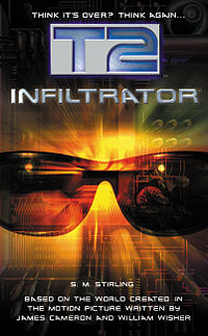Not counting the novelizations, it took a remarkable 17 years after the first movie for the first “Terminator” book to be released: S.M. Stirling’s “T2: Infiltrator” (2001), the first of a trilogy. Fans at the time no doubt loved the opportunity to kick back with a highly decompressed novel about Sarah and John and the latest threat from the future. When he started writing the trilogy, Stirling did not know that a “Terminator 3” would be made a couple years down the road; so at the time, this book trilogy was “T3” in a sense.
Today, the book (513 pages in paperback form) comes off as overwritten and repetitive of the structure from the two movies, complete with a Terminator from the future, a new ally and a climactic attack on Cyberdyne. Still, by the simple fact that it’s a novel, we are allowed to spend more time getting to know John and Sarah. Plus, “Infiltrator” is perhaps most well-known for introducing the human, Dieter, who would become Skynet’s facial model for the Arnold Terminator.
CHARACTERS
John Connor: Now 16, John is a dream kid, a slight contrast from the more traditionally troubled teen of “The Sarah Connor Chronicles.” He attends military school in Paraguay where he’s well-liked by the teachers and his fellow students. In the 2029 scenes, John holds the rank of general.
Sarah Connor: Calling herself Suzanne Kreiger, she runs a shipping business in tiny Villa Hayes, Paraguay. She and John are wanted by the L.A. police for the murder of John’s foster parents.
Dieter von Rossbach: If “Infiltrator” had been made into a movie, this was the role written for Arnold. The Austrian von Rossbach, a good-hearted retired international spy, is the face Skynet would later use for its earliest Infiltrator models that looked convincingly human. By random chance, he moves in next door to the Connors in Paraguay and eventually they become allies.
Jordan Dyson: Miles’ younger brother is an FBI agent (and later a Cyberdyne employee) who believes the official story that Miles was killed by the terrorist Connors. Tarissa and Danny eventually tell him the truth, and he eventually believes it, and even helps save John’s life toward the end of the book.
Paul Warren and Roger Colvin: The Cyberdyne president and CEO, respectively, are basically the same characters as Greg and Jack from the Frakes novelizations of “T1” and “T2.” Why Stirling changed their names is unknown, but “it’s a new timeline” could be the in-universe explanation for why different people are running Cyberdyne here.
TERMINATORS
Serena Burns (a T-950 model): There had been Terminator-human hybrids before, notably Dudley from the Dark Horse Comics timeline that springs from “T1.” But he is a human who had Terminator parts added to him. Serena is a human who has had a computer in her brain since her lab-based birth in the future; as such, she is utterly loyal to Skynet. She also undergoes accelerated growth like the clone troopers in “Star Wars.” Upon time-traveling back to 2001, she gets a job at Cyberdyne in order to see that its progression into Skynet goes smoothly — the same mission embarked on by the T-1000 in “Cybernetic Dawn” and the T-1000 Catherine Weaver in “The Sarah Connor Chronicles.”

T-101As: These Arnold models were called T-800 model 101s in previous stories, but Stirling calls them T-101As, “the originals.” Serena creates a handful of them in a homemade nutrient bath in 2001, utilizing computer chips smuggled under her skin from 2029 along with modern-day materials. “The Sarah Connor Chronicles” would later borrow this method for building homemade Terminators.
T-90s: Called T-600s in past stories, Stirling calls the basic endoskeleton model a T-90.
CONTINUITY AND CONTRADICTIONS
“Infiltrator” is set in 2001, six years after the events of “Terminator 2: Judgment Day.” The events of the Malibu Comics series “Cybernetic Dawn,” which begin right after “T2,” are contradicted at several points. The real-world explanation is likely that Stirling ignored the Malibu Comics, even though they had the blessing of James Cameron’s studio. The in-universe explanation is that an instance of time travel in “Cybernetic Dawn” (namely the T-1000 who inserts herself into Cyberdyne) created a new timeline for that story. “Infiltrator,” on the other hand, is the “T2” timeline that happened before (in a meta-time sense) it was overwritten by the “Cybernetic Dawn”/“Nuclear Twilight” timeline, thus explaining why the events of those comics are never mentioned by any characters.
Notable differences between Malibu Comics’ story and Stirling’s story include:
- In the comics, Tarissa Dyson and her kids, Danny and Blythe, go on the run with the Connors. In the book, the two families don’t even talk to each other. There’s no animosity, though, as Tarissa does not hold the Connors responsible for her husband’s death.
- The Salceda patriarch is killed by the Robert Patrick T-1000 in a flashback scene in the comics (sort of a “deleted scene” from the movie). In the book, the family is alive and well, and at their same California desert location.
- In the comics, Judgment Day had happened by the turn of the millennium (although an exact date isn’t given). The book takes place in 2001, and J-Day hasn’t happened yet.
A notable similarity between “Cybernetic Dawn” and “Infiltrator” is the link between the government and the company that will become Skynet. In the comic, NetWork Developments has federal agents ensconced in the company, and in the novel, the government agent named Tricker is regularly looking over the shoulders of Paul, Roger and Serena at Cyberdyne.
Sarah theorizes about a Skynet “cyberdog” (page 203 of the paperback). The Now comics indeed featured a wolf Terminator, but that was part of the future war.
Stirling confirms that the factory at the end of the first movie was indeed Cyberdyne (p. 299). This was unclear in the movie and inconsistent between the two “T1” novelizations: The Hutson book said it was a Cyberdyne factory, whereas the Frakes novelization had it as an unnamed factory that employed Greg and Jack, who went on to form Cyberdyne using the computer chip and armature.
Skynet reads Hitler’s “Mein Kampf” and thus learns how to hate (p. 303). In almost all “Terminator” stories, Skynet is acting in self-defense when humans try to pull its plug, then it goes on to fight a strategic war for its own survival. But many of the spin-off materials add more elements to Skynet’s thought process, and sometimes it has “emotional” responses, such as in the Now Comics, when Skynet essentially keeps some of humanity around so it doesn’t get bored. So add the “learning how to hate” element to Skynet’s “emotional” knowledge.
TIME TRAVEL AND TIMELINES
“Infiltrator” features one instance of time travel: After Skynet’s defense grid is smashed by the resistance in 2029, it sends Serena back to 2001 as a last-ditch emergency measure. In previous stories, Skynet made the last-ditch effort of sending back a T-800 (or T-101A, in Stirling’s parlance) in “T1,” a T-1000 in “T2” and various other Terminators in the Dark Horse (“T1” timeline) and Malibu (“T2” timeline) comics. Stirling makes no reference to these other missions. But Serena emerges in a similar empty parking-lot location to the movie villain Terminators, so I think the author is implying that she traveled from the same Los Angeles-based TDE. Whether Serena was able to say hi to the movie Terminators before they went on their various merry ways, or whether she is on a different timeline, is unknown at this point in Stirling’s trilogy.
Stirling rather smartly posits a single, elastic timeline with possible temporary branches (which will eventually snap back into place) as a way to reconcile the saga’s conflicting interests in “fate” and “the future is not set.” Conversations between Skynet and Serena reveal the supercomputer’s take on time travel, based on the contradictions in its files. For example, its files show that J-Day happened in 1997, but also in 2000 (p. 68). Some records show that an I-950 like Serena played a role in its creation, but other records show no role for a T-950. Skynet concludes:
“The highest probability is that there is a … temporal fluctuation involved. Time is malleable but not easily manipulated. In verbal terms, it has an inertia. When artificially diverted, it seeks to resume its original path. While matters are in doubt, several alternative world-lines can coexist in a state of quantum superimposition.”
The very fact that Skynet has records from multiple timelines perhaps gives “Infiltrator” synergy with Dark Horse’s “Endgame” and “RoboCop versus The Terminator,” both of which show the shifting of time before characters’ (and readers’) very eyes. While I tend to write off such visual portrayals as an artistic way to show a changing timeline, rather than something people are literally experiencing (other than perhaps through a sense of déjà vu) – simply because the idea of a person experiencing a timeline shift is insane — those portrayals certainly adhere to the “single, changeable timeline” theory rather than the “multiple timelines” theory. A timeline on a multiverse should only have one set of historical records, whereas a timeline that has undergone shifts perhaps has multiple, contradictory sets of records. Precisely why the records don’t get overwritten when the timeline gets altered is unclear, but until I come up with a better explanation, I’ll argue that supercomputing power is a match for time-shifting power, and thus Skynet can retain knowledge from before time-shifts happen. This leads us to the sci-fi concept of a supercomputer being a match for God, and the “Terminator” saga is barely toeing the line of that trope, so I’ll shelve this line of thought for now.
Sarah’s thinking about timelines is similar to Skynet’s (p. 361). She tells Dieter she has two missions: To keep John alive and to prevent Skynet from being built. She’s beginning to suspect the latter “may be an impossible task. One thing I’m learning is that changing how things are supposed to be is like pushing on a rubber wall. It might take time, but it will return to its original shape, or close to it.”

